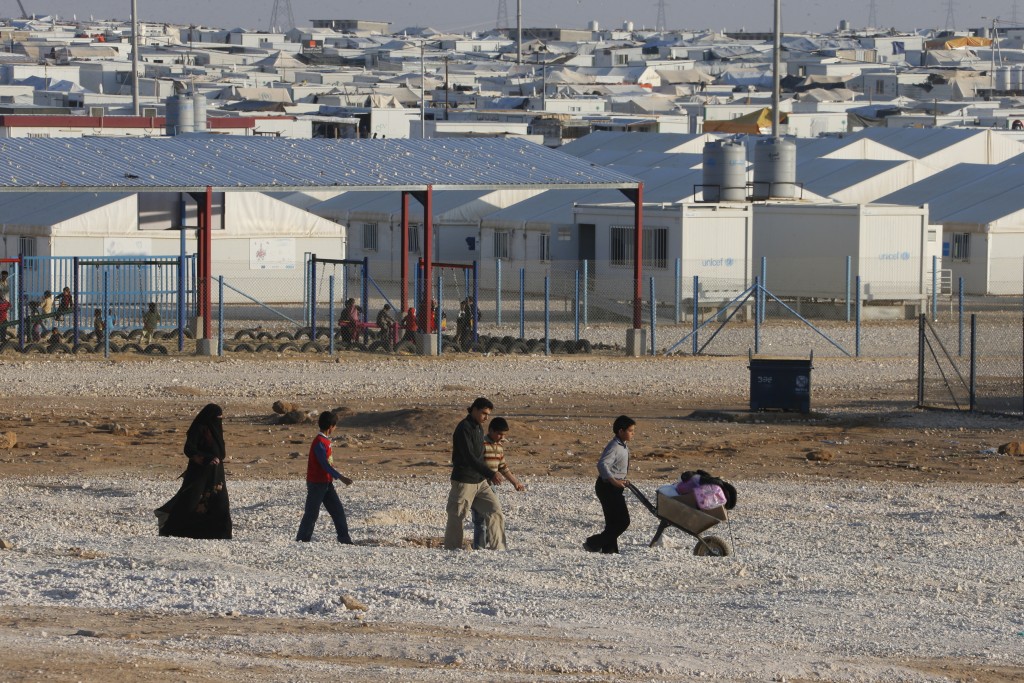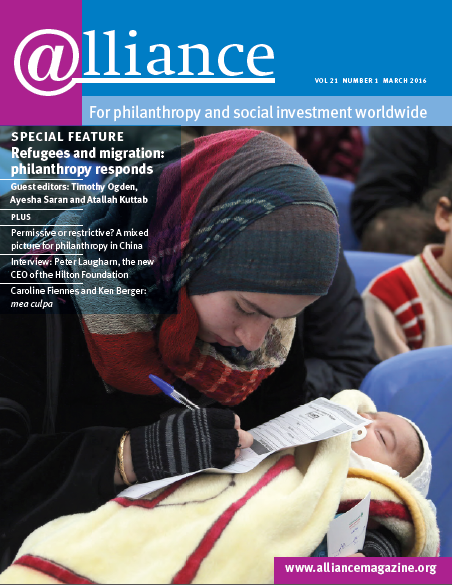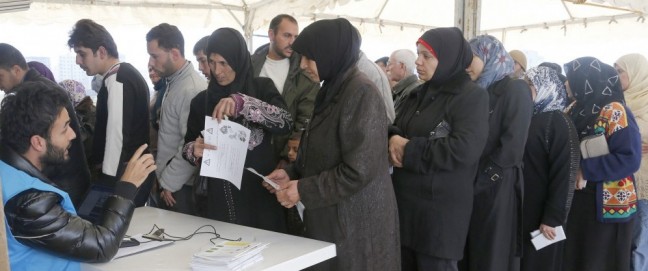It is a rare event that captures global philanthropy’s attention. The stream of refugees from Syria is one of them. There is a serious humanitarian crisis under way, and a rapid response is called for. How is philanthropy responding? And how should it respond? These are the broad questions this issue of Alliance aims to address.
The very present and visible nature of the Syrian crisis is commanding attention. But, as always, the attention lavished by the media and the public misses much more than it takes in. The number of refugees reaching Europe is a small fraction of those who have fled Syria, which in turn is a fraction of those who remain trapped in the country under daily threat from violence and deprivation. And Syrians are only a small part of the global population of refugees and internally displaced people.
There is no way we could give a truly comprehensive perspective on migration and refugees. While we do look at the situation of displaced persons in Colombia and those fleeing violence in Central America, we have not touched on the serious and ongoing issues arising from war, violence and conflict in Afghanistan, and in many other countries and regions affected by conflict in the last few years. But we have tried to cover a diverse set of issues, contexts and questions, and we hope this will prove relevant to other situations that are less visible but no less important.

Children earn a living by transporting goods inside the Zaatari Refugee Camp, Jordan.
Credit: Mohamed Azakir – World Bank
What can philanthropy do?
A dramatic crisis like this that attracts attention yet overshadows deeper, wider and longer-standing problems is a challenge for philanthropy. It plays to both philanthropy’s strengths and its weaknesses.
There are aspects of the crisis that philanthropy should, in theory, excel at: it requires quick action, tolerance for risk, and willingness to take on unpopular tasks. At the same time, the current situation has many aspects that philanthropy has historically struggled with: it requires systemic action in several domains simultaneously, though it’s not at all clear what is most likely to have an impact; it requires widespread and ongoing collaboration; it calls into question existing commitments and strategies; and the root causes are outside the reach of philanthropy (even philanthropy’s most ardent supporters don’t claim that it can stop wars when many of the parties involved have no interest in peace).
‘One area where philanthropy organizations are well suited to act is helping refugees and migrants adjust to the new societies they are arriving in.’
One area where philanthropy organizations are well suited to act is helping refugees and migrants adjust to the new societies they are arriving in. Investing in long-term programmes that promote meaningful engagement between migrants, refugees and established residents is one way to do this. In the current crisis, foundations could be well placed to forge partnerships with NGOs in eastern Mediterranean countries (Lebanon, Jordan, Palestine, Syria) to help ensure that programmes to help Syrians adjust to life in their new countries are sensitive to both refugees and host communities.
Who qualifies for aid?
One thorny issue related to the current crisis is who ‘qualifies’ for aid. Clearly refugees who are fleeing from imminent violence do qualify, but what about those whose opportunities and prospects have been destroyed by war but who are not in imminent physical danger? Or those who aren’t fleeing violence from military groups but from criminal gangs? Where do we draw the line between those whose lives and assets have been upended by war and those who are seeking a better life because they are denied access to opportunity and basic protections? Does philanthropy’s responsibility, and therefore response, differ based on these classifications? In light of the uncertain answers to these questions, we decided to include both people fleeing from violence and people fleeing from poverty, knowing that in many instances the two are closely related.
‘Where do we draw the line between those whose lives and assets have been upended by war and those who are seeking a better life because they are denied access to opportunity and basic protections?’
What the special feature covers
In the first section, we offer some context. Dilip Ratha of the World Bank provides data on refugees and worldwide migration. We also look at the situation in the Middle East, where the majority of Syrian refugees are; the special issues faced by women refugees; and the policy and public response to inflows of refugees in Germany and Central and Eastern Europe.
From there we turn to how foundations are responding to the situation. Ayesha Saran provides an overview of the role of philanthropy, while Andrew Milner and Charles Keidan extract findings from two surveys of European foundations. We also look at the European Programme for Integration and Migration and the efforts of the Bodossaki Foundation in Greece. From there we cast the net wider, both geographically and figuratively.
Marieke Bosman describes her foundation’s efforts to engage the Syrian diaspora in channelling aid to Syria, while Atallah Kuttab describes similar efforts to mobilize the Palestinian diaspora, who have been refugees in some cases for more than 50 years. We also look at Canada’s unique programme of ‘citizen philanthropy’, which empowers private citizens to sponsor refugees; and the efforts of Colombian corporate foundations to aid internally displaced people in that country and foster peacebuilding.
Just as the impact of Syrian refugees in Turkey and Lebanon has received less attention than the much smaller numbers arriving in Europe, coverage of the arrival of people from Central America in the US has largely overlooked what happens as they try to cross Mexico. Susan Seijas documents the experiences of Central Americans and how US philanthropic aid seems to be pulling back despite growing need. Finally, Will Somerville analyses long-term philanthropic efforts to change the dynamic of the wider debate about refugees and migrants.
In the third section of the special feature, we consider what more philanthropy could be doing, looking beyond current crises. Timothy Ogden argues that migration is a global good and thus deserves philanthropic support. Michael Clemens and McBride Nkhambala separately make the case that migration is a highly effective anti-poverty strategy and should be part of the toolkit for any foundation fighting poverty. Alexander Berger describes the search for strategies to support more migration and better outcomes for migrants. And, befitting the controversial nature of this topic, Ayesha Saran sounds a note of caution about the negative outcomes and unintended consequences of migration.
Finally, Bassma Kodmani of the Arab Reform Initiative provides a powerful endnote, returning us to the current crisis in Syria, and her hopes for the future of the Syrian people at home and abroad. She also eloquently reminds us of the need to involve those affected by the crisis in their own destinies.
How much should foundations do?
This special feature covers a lot of ground; yet there is an overarching question that we have not addressed: how much should foundations do about the current crisis? There is clearly a desperate need, but other issues that foundations were addressing have not gone away. Indeed, the fear that the needs of refugees and migrants will trump those of people already in a country underlies the populist pushback against aid and welcome. The June issue of Alliance will focus on climate change, another area that calls out for urgent and massive support from philanthropy.
As we write this, headlines are being written about imminent famine in Ethiopia and Zimbabwe. Households affected in those countries are for the most part too poor and too distant to make their way to Europe or North America and as a result many fear that their need for aid will not be met. The Center for Global Development has already documented European countries reallocating aid dollars away from planned development investment in other parts of the world to fund programmes for refugees.
Our hope is that this special feature will help you to seriously consider the question: how should you respond?
Timothy Ogden is managing director of the Financial Access Initiative at NYU-Wagner and a contributing editor to Alliance. Email timothy.ogden@nyu.edu
Ayesha Saran is programme manager – migration at Barrow Cadbury Trust. Email a.saran@barrowcadbury.org.uk
Atallah Kuttab is founder and CEO of SAANED for Philanthropy Advisory in the Arab Region. Email akuttab@saaned.com




Comments (0)